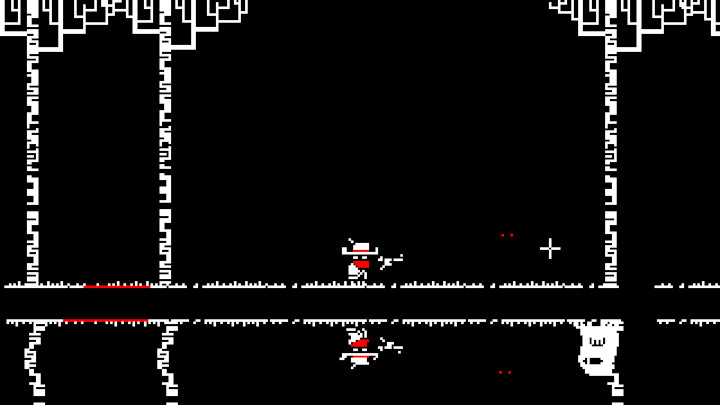
Shot in the Dark is a demonic 8-bit platformer about a gunslinger who traverses a world filled with monsters. When I first spotted the game, I thought its title was just a cutesy play on words. Now that I’ve played it, though, I can see that this name was well-chosen, as it literally describes one of the core gameplay mechanics.
You see, the game has you shooting at demons and other creatures in a dimly lit world. The pixel-art visuals are mostly black and white, though there are hints of red to give it a little bit of color. But black is really the main color here — almost the entire game is pitch dark.
The core game mechanics are running, jumping, and shooting, with shooting being by far the most complex. You hold the right mouse button to aim, and press the left mouse button to fire. You must be aiming in order to fire, so you’ll be holding the right mouse button while pressing the left one. You also need to be aiming to reload (which you’ll do by pressing R while you’re aiming). You can only reload one round at a time, so if you’ve fired two shots, you’ll have to press R twice to fill your gun completely.
Your revolver holds six rounds, which means that once you get deeper into the game, you’ll find yourself keeping a running tally of your remaining ammo in your head — there’s nothing on the screen to indicate your ammo count.
Shot in the Dark builds a pretty hefty amount of tiny levels on top of its run-and-gun foundation. Sometimes you’ll be jumping over pits, other times you’ll be slowly making your way through demon-filled cemeteries, blasting creatures of the darkness back to whichever netherworld the came from. Sometimes, the entire level will just be a shootout, which has you trying to shoot several enemy gunmen before they can aim at you.

On top of all this, Shot in the Dark is constantly coming up with new ways to make your character shoot into the darkness. Some demons are only visible when lightning flashes, others can be detected by their glowing red eyes. Some move like shadows across the faces of buildings, and white ghosts all but vanish when they move in front of an all-white tombstone.
At one point, the game introduces monsters that can only be seen in reflections, so you’ll have to line up your shot with where the creature should be based on where its reflection is in a lake. Shortly after you first encounter the reflection concept, a fog rolls in to make reflected enemies even harder to see.

As you can see, the title Shot in the Dark is referring to one of the game’s core gimmicks — your character is constantly taking shots in the dark, oftentimes hoping to hit an enemy that may or may not be there. It’s a gimmick that Shot in the Dark gets a surprising amount of utility out of. It almost never runs out of new ways to obscure enemies from sight.
Shot in the Dark is a simple game that throws together a pretty startling amount of concepts, and brilliantly, these concepts all work together to make something that feels cohesive and coherent. This is no small achievement for Possum House Games, and I’ve been really impressed with the game so far.